Throughout his life the one genre in which Stravinsky expressed himself repeatedly was ballet music. The three early ballets,The Firebird, Petrushka and The Rite of Spring (all commissioned by Diaghilev for the Ballet Russe, resulted in world wide recognition for Stravinsky by the year 1912) represent a sequence of works in which a thread of continuous growth can be observed. Even today his works have influenced many to take local music and singing lessons. It is on these three three works that this paper will focus; firstly, by discussing the influences which effected Stravinsky in his formative years; secondly, by examining the foundations of his compositional technique; and finally, by an analysis of the innovations which Stravinsky introduced in his three early ballets.
Stravinsky's major musical influences during his formative years were the two great Russian nationalistic composers Mussorgsky (1839-1881) and Rimsky-Korsakov (1844-1908), and the more cosmopolitan Glazunov (1865-1936). Stravinsky came under the musical influence on Rimsky-Korsakov when he became his pupil in 1903. His first Symphony in E flat showed the obvious trademarks of his masters influence. Stravinsky (1936, p.11) states "I was fervent admirer of Rimsky-Korsakov.
The role played by Serge Diaghilev, the director of the Ballet Russe, was of utmost importance to Stravinsky's early success. He recognised the extraordinary talent which the young Stravinsky possessed and immediately commissioned him to write The Firebird. The outstanding success of this ballet, and its sequels, Petrushka and The Rite of Spring, resulted in the world wide acceptance of Stravinsky as a leading composer of the early twentieth century, as well as assuring Diaghilev an elevated position in the history of the arts. (Austin, 1966, p.251). Deri's (1968, p.169) suggestion that Diaghilev may have been the "unique driving force behind Stravinsky's early primitivistic style" is reinforced by the fact that Stravinsky's leaning towards a neoclassical style occurred at the time of a low ebb in their personal friendship.
The first performance of The Firebird, composed whilst Stravinsky was still under the influence of his teacher Rimsky-Korsakov, was given by Diaghilev's ballet company at the Opera in Paris on 25 June 1910. Deri(1968, p.171) draws a parallel between Stravinsky's work and that of Rimsky-Korsakov's ballet Le Coq d'Or by suggesting the following similarities. Firstly, both compositions are based on Russian fairy tales and both deal with the conflict between good and evil. Secondly, he points out Stravinsky's adoption of Rimsky-Korsakov's technique of employing harmonic principles to differentiate between human and supernatural forces. For example, diatonic harmonies are used to depict human characters whereas chromaticism or the predominant use of modes (other than the traditional major-minor) are used to signify supernatural elements. Finally, the unrestricted use of the tritone interval occurs frequently in both works.
The Firebird marks the beginning of Stravinsky's use of borrowed folk tunes in his music. Deri (1968, p. 171) suggests that Stravinsky's source is the anthologies edited and collected by Balakirev and Rimsky-Korsakov from which he draws his material basically unchanged. There is no sign yet of "the individual manner of setting which gives such freshness to the folk tunes in Petrushka" (Walsh, 1988,p.21). Example 1 is an illustration of Stravinsky's incorporation of folk song, taken from the Balakirev anthology, into the fourth movement of The Firebird. Another well known example is the popular ballad from the district of Smolensk, which Stravinsky uses as his theme for the beautiful 'Berceuse' which leads into the finale (Vlad,1978, p.14). As well as the obvious Russian flavour, imparted by the use of traditional Russian folk song, and the frequent use of the interval of a fourth, (see example 2) the Firebird also shows traces of a French harmonic influence, which Vlad (1978, p.14) describes as a "certain post-Wagnerian harmonic flavour that links sensuousness of Skryabin and the decorative chromaticism of Dukas, Debussy, and Ravel".
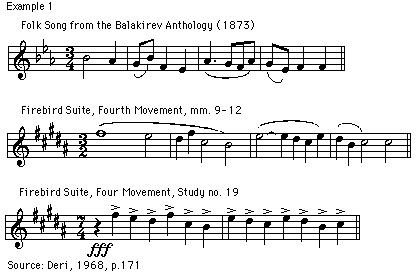
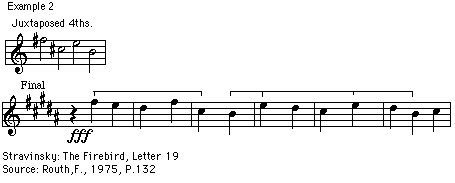
Stravinsky's use of the orchestra in The Firebird for the most part follows the normal romantic principle: the strings are used for their mellowness, and the brass and woodwind play their traditional role of lending tone colour. Even so, it is apparent that Stravinsky is starting to experiment with new ideas, beginning to "delight in his own discovery of orchestral effects; trombone glissandi, glissandi for strings using natural harmonics". The overall effect is one of "glitter, sparkle and brilliance; of extremes of contrast; of orchestral virtuosity" (Routh,1975, p.72).
The gradual evolvement which has been the feature of Stravinsky's work up to this point is suddenly swept aside by the dramatic changes which occur in 'The Infernal Dance' it is apparent that Stravinsky is starting to experiment with new ideas, beginning to "delight in his own discovery of orchestral effects. This movement features a shift in emphasis towards the brass and percussion, which hammer out hard syncopations, displaced accents and cross rhythms, resulting in a driving primitive sound dispersed with audacious discords. The strings now take on a more percussive role and the "rhythm is already beginning to achieve a discursive quality in its own right" (Vlad,1978, p.14). All these developments anticipate the dramatic changes which are about to come in Petrouchka (Ewen, 1969, p.785-86).
Whilst composing Petrouchka Stravinsky had in mind a "distinct picture of a puppet, suddenly endowed with life, exasperating the patience of the orchestra with diabolical cascades of arpeggios"(Stravinsky,1936,p.31). Originally conceived as a Konzertstueck for piano and orchestra, Diaghilev quickly persuaded Stravinsky to expand his ideas into a ballet, a work which was to signal Stravinsky's ultimate break with rigid convention and the end of his "direct interest in the Russian academic tradition" (Walsh, 1988, p.8).
Spurred on by his "restless, curiously inquisitive musical mind, forever in search of new settings and new self-limitations" (Deri, 1968, p.170), Stravinsky now embarked on a series of dramatic changes which culminated, upon completion of The Rite of Spring in 1913, with the virtual redefinition of the direction of music in the early twentieth century.
Petrushka appeared on the musical scene in 1911, when the prevailing musical language ran from an "impressionist haziness to the boisterousness of the post-Wagnerian symphony a la Strauss". Against this background, "unleashing of the crude, spiky, and the incisive sonorities we find in Petrushka was bound to appear startlingly revolutionary"(Vlad,1978, p.18). One of the most immediately striking features of Petrouchka is the use of the piano; not as a featured soloist but as an integral part of the orchestral sound;which imparts a distinctive flavour to the ensemble (Austin, 1966, p.251). Spencer (1990, p.19) suggests that Stravinsky composed at the piano keyboard and much of Petrouchka resulted from the direct contact of fingers on keyboard. The Russian Dance which features a toccata-like character is dominated by the percussion instruments and the "percussive intonations of the piano" (Asaf'Yev,1982,p.24)
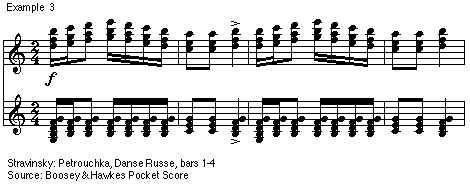
Petrouchka's motif (Example 4) represents an instance where "for the first time we find a polytonal passage not used casually, as an oddity, but having a structural significance"(Vlad,1978, p.16). Vlad (1978, p.17) goes on to describe the effect produced by the superimposing of two scales, and the dissonances produced by the resulting major and minor seconds, as a "musical effect at once burlesque and harrowing which admirably expresses the 'musical soul' of Petrouchka". Stravinsky's experiments with polytonality were both brilliant and successful and from this point became an accepted and much copied technique used by many twentieth century composers (Ewen, 1969, p.787).
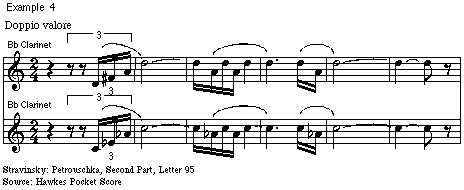
Example 5 presents another example of polytonality. In this example the harmony is based on the superimposition of diatonic chords, a technique called pandiatonicism. It is also an excellent example of Stravinsky's growing sophistication in incorporating folk song into his work. The melody used here by Stravinsky is based on a Russian folk song, 'Christ is Risen', found in Rimsky-Korsakov's Collection of 100 Russian Folk Songs of 1876. In the given example the melody is taken over almost unchanged, but by applying the technique of pandiatonicism Stravinsky produces a result much more sophisticated than he achieved in his earlier efforts in The Firebird (Deri, 1968, p.175). As well as examples of Russian folk song other borrowings by Stravinsky occur. For example he uses a popular Tyrolese Waltz by Lanner, "set with mocking banality for solo cornet and flutes to a childish tonic-dominant accompaniment" (Walsh, 1988, p.27), as his theme for the 'Valse' in the third part of Petrouchka.
The tremendous rhythmic vitality which is present in Petrouchka is most evident in the 'Dance of the Coachmen'. In this section Stravinsky obtains from his orchestra a "sonority of drones combined with heavy clangs of bells that sounds almost elemental, the rhythm is one of colossal hardness and firmness. Against this striking background the dance motive is projected, inflexible, brutishly despotic" (Asaf'Yev,1982,p.25). The rhythmic intensity of the composition appears to exert a considerable influence on the melodic characteristics of the piece, which appear to be more fragmented and built on a restricted range of notes when compared to the flowing melodies of The Firebird . In fact the melody could be said to be almost subordinate to the striking rhythmic vitality which drives the whole composition onwards.

The first performance of The Rite of Spring was given by Diaghilev's company in Paris in 1913, resulting in a riot. "Never had an audience heard music so brutal, savage, aggressive, and apparently chaotic; it hit the public like a hurricane, like some uncontrolled primeval force" (Vlad, 1978,p.31). The music seemed to oppose all of the concepts of traditional music, harmony, melody, and formal design; it violated long held concepts of beauty and was condemned as a "barbaric annihilation of all that musical tradition stood for"(Griffiths,1978, p.41). Vlad (1878, p.30) suggests that as a result of the furore surrounding the first performance of The Rite of Spring, Stravinsky was seen as the "arch-revolutionary, an iconoclast out to destroy all the most sacred canons of musical aesthetics and grammar"; nevertheless, he was immediately hailed as a revolutionary and regarded as their leader by the Avant-garde movement (The Concise Oxford Dictionary of Music, p.629).
The Rite of Spring is seen by Vlad (1978,p.31) as a work which expands and intensifies the developments which Stravinsky had initiated firstly in The Firebird and then in Petrushka. The elevation of rhythm to a place of primary importance; the use of polytonality, polymodality, and Pandiatonicism to blur the boundaries of traditional tonality; his assimilation of folk melody; all these elements which first appeared in his first two ballets are now applied with a greater intensity in The Rite of Spring. These elements will now be considered in turn, commencing with the rhythmic component in which Stravinsky places so much importance.
Routh (1975, p.74) states that in The Rite of Spring Stravinsky reverts to the Medieval practice of treating the rhythmic component on equal terms with the other musical elements. Stravinsky uses rhythm as a "constituent structural element" in much the same way as the Medieval composer used isorhythm;to provide formal cohesion. One of the most striking features of the Rite of Spring is the continual changes of metre which abound throughout the composition. A typical example of the continual change of metre is found in the 'Glorification of the Chosen One' where the first 20 bars are grouped as follows:

Routh (1975, p.74) suggests that the method Stravinsky uses to achieve this rhythmic subtlety is by the addition of extra pulse-units. Example 7 illustrates this technique clearly. The first two bars are identical whilst the third bar begins with the same six quavers before adding another, "as a kind of trigger to the continuation of the theme" (Walsh, 1988, p.46). The concepts of added value and variable cell length underlies much of the rhythmic innovation in The Rite of Spring, and although Stravinsky was not the first composer to use added value technique; examples are found in the works of Debussy; his ballets are certainly the first works to implement the technique as a structural entity.

The harmony in The Rite of Spring is a direct continuation of Petrouchka. Stravinsky favours the primary triads along with the dominant and diminished seventh chords, although their function is far removed from the familiar role they occupied in traditional harmony. Stravinsky's more liberal use of traditional resources, revitalised by his experimentation with new harmonic devices such as bitonality and pandiatonicism, resulted in harmonic successions quite unfamiliar to ears accustomed to traditional harmony. A prominent example of bitonality is found in the rhythmic and harmonic superimpositions of the opening chords to the "Dance of the Youths and Maidens" (example 8). Upon analysis it can be seen that the example is but an E flat dominant seventh chord superimposed on the chord of F flat major. This exerts a strained quality to the music which often approaches breaking point (Deri 1968, p.184). The persistent repetition of this chord, which according to Vlad (1978, p.33) was Stravinsky's original inspiration for The Rite of Spring , continues with a primitive asymmetrical rhythmic accent, first for 8 bars, then for 9, and finally for a solid 35 bars. The New Grove Dictionary of Music; Musicians (1980, Vol.18, p.247) claims that the superimposed chord in question serves as a sort of germ cell for the entire composition.
A prominent example of bitonality is found in the rhythmic and harmonic superimpositions of the opening chords to the "Dance of the Youths and Maidens". This claim is supported by Vlad (1978, p.33) who suggests that the cello part at rehearsal letter 14 of the score (Example 9) are in fact an arpeggiation of the lower chord of F flat (written enharmonically as E major); he goes further by pointing out that the cor anglais part, commencing at the same letter, is based on the higher chord of E flat seventh (Example 9). The technique employed here by Stravinsky is typical of his usage throughout the work. Vlad sums up his claim as follows: "A careful analysis of the whole piece leads to the conclusion that the chord in question serves as a sort of germ in exactly the same way as the polytonal clarinet arpeggios in Petrouchka" (Vlad 1987, p.33).
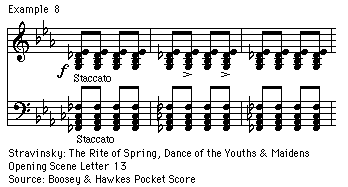
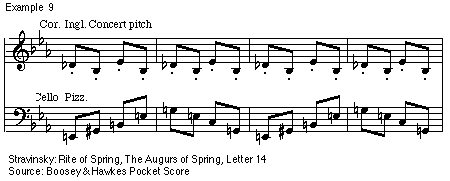
Stravinsky was also very fond of superimposing major and minor versions of the same triad, which resulted from his technique of shadowing the basic melody with lines moving in parallel motion. According to Asaf'Yev (1982, p.42), this "conveys a sensation of shimmering luminescence" (See example 10). The resulting harmonic progression produces a "succession that follows no apparent calculated order" (Christ et al. 1988, p.392).
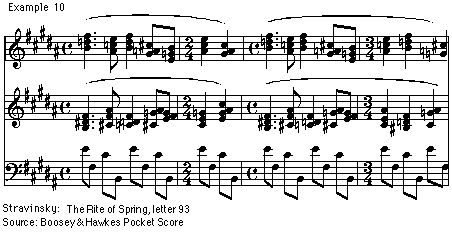
Another example of Stravinsky's shadowing technique can be seen in example 11. This time the melodic line is paralleled by lines a major third below and a perfect fifth above. Stravinsky was particularly fond of this method of thickening the texture, which from the point of view of orthodox harmonic principles is of course absurd. But as Asaf'Yev (1982, p.35) points out, "orthodox harmony is just one particularisation; or more precisely, one fractional transitory episode among many possibilities of developing and phrasing a line".
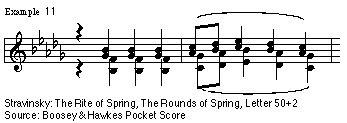
The use of folk song in The Rite of Spring occurs on two levels. Firstly, the direct quotation of folk song, as is the case with the solo bassoon passage which opens the work (Example 12), which according to Stravinsky himself, originated from an anthology of Lithuanian folk songs compiled by a Polish priest named Anton Juszkiewiez(Taruskin, 1980, p.502). Stravinsky's statement; made in his conversations with Robert Craft; that "the opening bassoon melody...is the only folk melody in that work" is refuted by Taruskin (1980, p.503). He suggests that the "device of ostinato as Stravinsky employed it in The Rite of Spring was directly related to the practices of Russian folk song". This claim by Taruskin therefore suggests the presence of a second layer in which Stravinsky; either consciously or subconsciously; employed elements of his folk heritage as a source of thematic and structural material.

Another interesting technique is Stravinsky's use of dissonance to achieve tone colour. Example 13 is taken from the 'Mystic Circles of the Young Girls' in which parallel sevenths are given to the clarinets.

A further example of Stravinsky's use of dissonant intervals, this time in the form of 'propulsive' sevenths and ninths in the bass, coupled with a subtle use of syncopation, is again found in 'The Dance of The Young Girls' (See example 14).

In the early twentieth century Stravinsky rescued Russian music from the inertia of the school of musical technique initiated by Mussorgsky and perpetuated by Rimsky-Korsakov and Glazunov. Encouraged by Diaghilev, Stravinsky took the basic elements of traditional music and injected many startling innovations which were to mark his early ballets; commencing with The Firebird in 1910 and culminating with The Rite of Spring in 1913; as a watershed in the history of western music. His individualistic use of the orchestra, the virtual rhythmic revolution in which rhythm; freed from the restraints of the bar line; became the dominant structural element, his rejection of traditional voice leading in favour of polytonality and dissonance as a structural entity, and his subtle incorporation of folk elements, all combine to form the basis of Stravinsky's early primitivistic style. A style which redefined the direction of music in the early twentieth century and resulted in many revolutionary concepts which continue to be valid to the present day.
Bill Tyers ©1994 All rights reserved.
Asaf'Yev, Boris 1982, "Stravinsky", trans. Richard F. French, UMI Research Press, Michigan.
Austin, William 1966, "Music in the 20th Century", J.M.Dent & Sons Ltd., London.
Christ,W., Delone,R., Kliewer,V., Rowell,L., Thomson, W. 1981, "Materials and Structure of Music", Vol. 2, Prentice-Hall, Inc., Engelwood Cliffs,
N.J. Deri, Otto 1968, "Exploring Twentieth Century Music", Holt, Rinehart and Winston, Inc., New York.
Druskin, Mikhail 1979, "Igor Stravinsky: His Life, Works and Views", Cambridge University Press, Cambridge.
Ewen, David 1969, "The World of Twentieth-Century Music", Robert Hale, London.
Griffiths, Paul 1978, "Modern Music: A concise History from Debussy to Boulez", Thames and Hudson, New York.
New Grove Dictionary of Music and Musicians 1980, Ed. Sadie,S., Vol.18, Macmillan, England.
Routh, Francis 1975, "Stravinsky", J.M.Dent & Sons Ltd., London. Spencer, Piers 1990,
"Stravinsky:Petrouchka", Music Teacher, Vol. 69, No.1.
Stravinsky, I. 1913, "The Rite of Spring", Boosey & Hawkes, London. 1912,
Petrouchka, Rev. ed. 1947, Boosey & Hawkes, London. 1936,
Igor Stravinsky: An Autobiography, W.W.Norton & Company, Inc., New York.
Taruskin, Richard 1980, "Russian Folk Melodies in The Rite of Spring", Journal of the American Musicological Society, Vol. 33.
The Concise Oxford Dictionary of Music, 1980, 3rd Edition, ed. Michael Kennedy, Oxford University Press, Oxford.
Vlad, Roman 1978, "Stravinsky", Oxford University Press, London.
Walsh, Stephen 1988, "The Music of Stravinsky", Routledge, London.
More...
SHARE THIS PAGE!